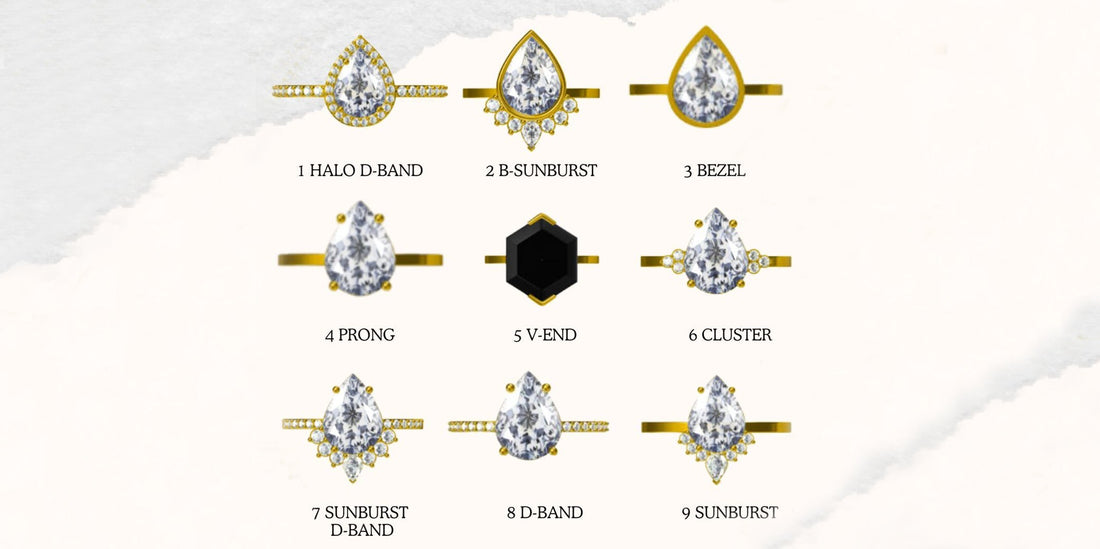
Diamond & Ring Setting Types: Ultimate Guide
Share
Our Guide to Diamond & Ring Setting: Something special for each of your moods.
Engagement rings are some of the most precious gifts that you will be gifting to your partner, So making it special is very important. A comfortable diamond & ring setting allows them to enjoy seamless comfort, while slaying the look.
So, now we understand how overwhelming can a diamond & ring setting selection be! Therefore, whether you are looking for a classic setting or want to upgrade your setting with some vintage styles, we have just the right guide for it.
Learn about prong settings, their types, which one works the best for your diamond cut and so much more in this blog.
What Is a Prong Setting?
Prong settings are the small claws that hold your diamond in place with a better grip, but also now prong settings come in various styles and types, each setting enhances the way your diamond shines in the ring. So, lest looks for it.
A prong also defines how securely your diamond is safe in the setting. That’s why making sure that you have the right setting is very crucial.
Most Popular Diamond & Ring Prong Settings:
There are several styles of prong settings, but each its own benefits. So, here are the ones you’ll see most often:
1. Four-Prong Setting
-
A simple, but classic look that lets in plenty of light.
-
Works well for round, princess, and oval-cut diamonds.
-
Provides a balance between security and sparkle.
-
Slightly less secure than six-prong settings.
2. Six-Prong Setting
-
Offers more protection by holding the diamond more firmly.
-
Best for round diamonds, especially larger ones.
-
Gives a more balanced and symmetrical look.
-
Reduces light exposure slightly compared to four prongs.
3. V-Prong Setting
-
Designed for diamonds with sharp corners, like princess, pear, or marquise cuts.
-
Protects the pointed edges from chipping.
-
Adds a slightly bold, but structured look to the ring.
4. Double-Prong Setting
-
Features two prongs at each point instead of one.
-
Adds extra security while keeping a delicate appearance.
-
Commonly used either for large diamonds or fancy cuts like cushion or emerald.
5. Tulip or Petal Prong Setting
-
Prongs are shaped like flower petals for a decorative touch.
-
Works well with either vintage or floral-inspired designs.
-
Adds a unique, but artistic element to the ring.
What Is the Most Secure Diamond & Ring Setting?
If security is your top concern, here’s how different settings compare:
|
Setting Type |
Security Level |
Best For |
|
Bezel Setting |
Maximum security |
Active lifestyles, rough wear |
|
Six-Prong Setting |
Very secure |
Round diamonds, larger stones |
|
Double-Prong Setting |
High security |
Large or fancy-cut diamonds |
|
V-Prong Setting |
Good protection |
Sharp-edged cuts like princess or pear |
|
Four-Prong Setting |
Moderate security |
Classic look, everyday wear |
A bezel setting is one of the safest and best settings for diamonds that are too crisp. If you have an active lifestyle so, this setting allows you to move freely without fearing the chipping of the diamonds.

How Many Prongs Should an Diamond & Ring Setting Have?
The prongs can directly affect the look and feel of your diamond ring.
-
Four prongs: Classic, minimal, and allows maximum light exposure but, Best for diamonds under 1.5 carats.
-
Six prongs: Adds more security, especially for larger stones. Works well for round diamonds.
-
Double prongs: A stylish choice that enhances durability, often seen on emerald or cushion-cut rings.
-
V-prongs: Protects corners of diamonds with sharp edges, like marquise or princess cuts.
For most people, the choice comes down to four vs. six prongs. If you want more sparkle, but a lightweight feel then go with four. If you prioritize security,then six prongs are the better option.

Claw Prongs vs. Round Prongs.
The shape of the prongs also makes a difference in both style and security.
Claw Prongs
-
Get a pointed, tapered-shaped diamond that grips the diamond securely.
-
This setting gives the ring a modern, but also high-end look.
-
Work well with round, oval, and cushion-cut diamonds.
-
Can make the diamond appear slightly larger.
Round Prongs
-
Have a smooth, but rounded tip that blends seamlessly with the diamond.
-
Offer a softer, but more traditional appearance.
-
Common in vintage and classic solitaire rings.
-
Slightly less aggressive grip than claw prongs.
Claw prongs give the ring a sleek, sharp finish, but a round prongs are more subtle and classic. So, Both options are great.
Best Diamond & Ring Setting for Different Diamond Cuts
Not all prong settings work equally well for every diamond shape. So, here’s a quick guide:
|
Diamond Shape |
Recommended Prong Setting |
|
Round |
Four or six-prong setting |
|
Princess |
V-prong or bezel for sharp corners |
|
Oval |
Four or six-prong, claw prongs for a sleek look |
|
Cushion |
Four-prong, double-prong for added security |
|
Emerald |
Four-prong or bezel for an elegant feel |
|
Pear |
V-prong for the pointed tip |
|
Marquise |
V-prong for both pointed ends |
When you choose a round diamond, a four-prong or six-prong setting will work best but, if you have a pear or marquise cut, a V-prong setting is a must to protect the pointed edges.
How to Choose the Best Prong Setting: According to Your Lifestyle
So, here is how you can set the best setting for your diamond cut and lifestyle.
-
If you have an active lifestyle, you must opt for a six-prong or double-prong setting for extra security.
-
For maximum sparkle and a lightweight feel, a four-prong setting would be the best choice.
-
For diamonds with sharp corners (princess, pear, or marquise), a V-prong setting is the safest choice.
-
If you crave something unique, but also stylish go for claw prongs.
The best choice for your Diamond & Ring Setting: Overview.
Everyone has a different style, lifestyle, and choices. So, here’s a quick review on how to do it right!:
If you want your diamond to sparkle at its best, then go for a four-prong setting, it lets in the most light. ✨
If security is your top priority, a six-prong or double-prong setting will keep your diamond extra secure.
Got a sharp-edged diamond? A V-prong setting helps prevent chipping and keeps it safe.
Want something bold but, modern?, Claw prongs add a sleek, stylish edge.
Prefer a classic but, a timeless touch?, Round prongs are always a safe bet.
Now that you understand the best settings for your diamonds, so Let’s make a ring that celebrates your story.








